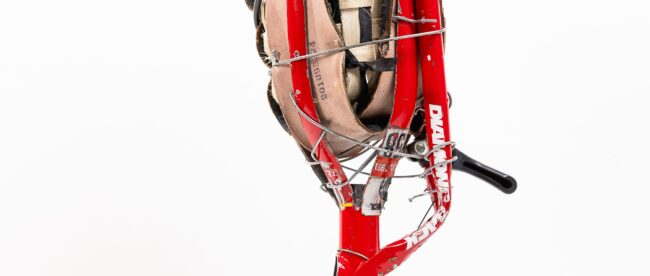The Bike Leg Project: How One Prosthetist is Building Low-Cost Limbs from Bicycles
Ben Hogan, a certified prosthetist and orthotist, is tackling the global challenge of prosthetic limb accessibility by fabricating them from bicycle parts. Troubled by the World Health Organization’s finding that only 1 in 10 individuals needing a prosthetic receive one, Hogan developed a functional, lightweight, and reliable prosthetic leg for those with below-the-knee amputations. His design reimagines the bicycle frame, already engineered to support human weight, into a prosthetic limb, with the wheel and spokes forming the foot and a custom-woven basket serving as the socket.
Driven by his background as a bike mechanic, Hogan is passionate about evolving the field of prosthetics. He intends for his innovation to be a paradigm shift, making prosthetic care more attainable. To this end, he is actively sharing his methods and plans to present his “bike leg” at an international conference, aiming to disseminate this knowledge globally rather than keeping it proprietary.
The assembly of the bike leg is an intricate process requiring considerable technical skill. It begins with the deconstruction of a steel bicycle frame, retaining only the seat tube and seat stays. The seat tube is then quartered to create four uprights which are bent and molded to the patient’s limb, with two positioned on either side of the shin and two at the back. A custom basket is woven around the upper part of the limb to form the socket, which should not extend above the kneecap or behind the knee. The seat stays are then bent, trimmed, and riveted to the rear uprights. Crossbars are fashioned from the bike’s chainstays and riveted to the front and rear uprights. Sections of a tire are riveted inside the uprights to act as a suspension “trampoline” for the socket. The foot is made from two equal lengths of the wheel rim, which are shaped into a rocker. Spokes are run through the rim sections and attached to the seat’s frame to connect the foot. The entire prosthesis is suspended using a piece of a bicycle tube, and the final adjustments for fit and comfort are made. The complexity of the tasks, which involve metal cutting, bending, and riveting, suggests that the assembly is quite difficult for someone without a background in mechanics or fabrication.
Analysis of the “Bike Leg”
Bike Parts and Difficulty Level:
The construction of the prosthetic leg utilizes a range of bicycle components:
- Frame and Stays: The steel frame’s seat tube and seat stays provide the core structure.
- Chain Stays: These are repurposed for creating stabilizing crossbars.
- Wheel Rims and Spokes: Rims are shaped into a functional foot, which is then attached to the leg structure using spokes.
- Tire and Tube: The tire is used for the socket’s suspension and as tread for the foot, while the tube helps to suspend the entire prosthesis.
- Shifter and Cable: These parts are used to create compression.
The difficulty level is high, demanding skills in metalworking, such as cutting and bending steel, and riveting. A fundamental understanding of biomechanics is also crucial to ensure the prosthetic is shaped and fitted correctly for the user.
How, When, Where, and Why This is Helpful
This innovative approach is most impactful in low-resource environments where conventional prosthetic technology is not available or is prohibitively expensive. Bicycles are ubiquitous worldwide, making them a readily available source of materials. The “why” is compellingly answered by the vast number of people living without necessary prosthetic devices. Hogan’s project offers a viable solution to this widespread issue.
The “bike leg” is particularly advantageous in developing nations and remote areas. It empowers local technicians to build and maintain prosthetics using local resources. In comparison to other low-cost alternatives like 3D printing, the bike leg offers distinct advantages:
- Accessibility and Durability: 3D printers require stable electricity, specialized materials, and technical know-how, which can be scarce in some regions. Discarded bicycles are far more common. A steel-framed prosthetic is also significantly more durable, especially on rough terrain, compared to standard 3D-printed plastics.
- Repairability: A damaged bike leg can be repaired using basic mechanical skills and spare bicycle parts, which are much more accessible than the resources needed to reprint a broken 3D-printed prosthetic.
In essence, Hogan’s “bike leg” presents a practical, durable, and accessible alternative for prosthetic care in many parts of the world where the need is most critical.
Watch the videos below to learn more about the Bike Leg and how it’s been helping people. You can also watch the full process of making the Bike Leg on Ben’s website.
Google’s AI assistant, Gemini, was used to help create this article. It assisted by summarizing the original source article and analyzing a detailed PDF to create the step-by-step assembly instructions. Gemini then synthesized the information from both sources into a comprehensive post. The tool also helped generate the post’s title, description, keywords, and image alt text.


Leave a comment